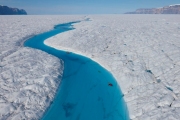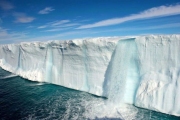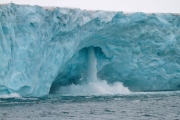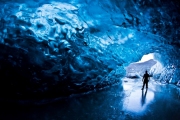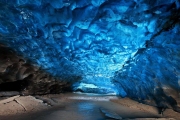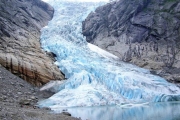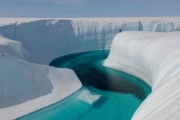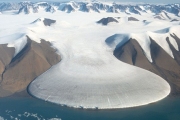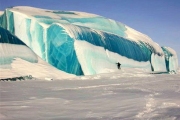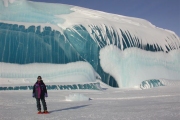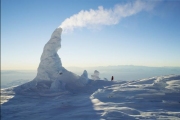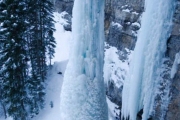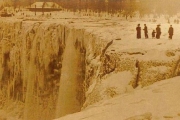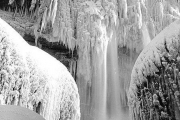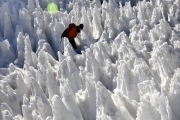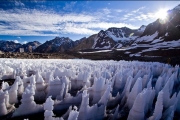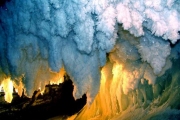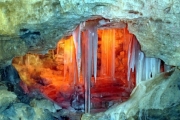|
Viewings: 9843
Many of these natural wonders are able to see only a scientist, as they are in the cold, sparsely populated areas of the planet.Here are the 10 most beautiful ice formations of nature from glaciers, frozen waterfalls up to the ice caves and icebergs. 1. Blue river, Greenland glaciers It is amazing blue river formed by the melting of Petermann glacier in Greenland, which have filled low-set area of blue water. Places filled with water seasonal change that every time alters the shape of the river. Bright blue color comes from glacial silt. 2. Glacial waterfalls, Spitsbergen (Svalbard) Svalbard or as it is called Spitsbergen is an archipelago in the Arctic, located in the Northern part of the Kingdom of Norway. Despite the proximity to the North pole, Svalbard relatively warm place due to the influence of the Gulf stream. This is a large area of the Islands, of which 60 percent is covered by glaciers. Some of these glaciers are formed small waterfalls from melting snow and ice, which can be seen in the warmer months. Huge glacier Prosulpin located on the second largest island - North-East Land 200 km long covered with hundreds of such melting waterfalls. 3. Ice cave, island of Iceland This amazing cave of the lagoon Sv?nafellsj?kull in Iceland was created by glacial cap volcano TV in a national Park Skaftafell. Beautiful blue was formed in the result of the fact that for many centuries the ice compacted, squeezing all the air. Due to the lack of air in the ice, it absorbs a lot of light, and the cave has a unique texture and color. Safest place to visit an ice cave in winter, and for better visibility - after the rains. Many of those who were lucky enough to be inside the cave, he heard a cracking sound. However, these sounds are not due to the fact that the glacier may collapse, and because he is constantly moving. 4. The Glacier Briksdalsbreen, Norway Briksdalsbreen is one of the most famous bag glaciers of Jostedalsbreen-largest glacier, located in Norway. It ends with a small glacial lake, located at 346 metres above sea level. Tourists from all over the world come to admire the glacier Briksdalsbreen, located amidst waterfalls and mountains. 5. Ice canyon, Greenland This Ice canyon in Greenland depth of 45 meters was created by melt water as a result of global warming. On the edge of the canyon, you can see the line that shows the layers of ice and snow, formed over many years. Dark sediments at the bottom of this channel is cryoconite, dusty material formed in the result of weathering. It is deposited on the snow, glaciers and ice caps. 6. Glacier "Elephant paw", Greenland This huge glacier named "Elephant paw" is located in the Northern part of Greenland. The gray area in the lower part of the glacier - melt zone, which was formed from meltwater channels. Almost perfect round shape of the glacier has a diameter of about 5 km. 7. Frozen wave, ice flows of Antarctica Although at first glance it may seem that you are in a huge wave, which was frozen, it was not formed from water wave. This is actually blue ice that forms when compressed air bubbles are displaced. The ice looks blue because when light passes through his thick, blue light is reflected, and red, is absorbed. Himself ice formed over a long period of time, and re-melting and freezing gave forming a smooth appearance. 8. Striped icebergs, southern ocean 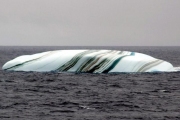 <img src="http://onua.org/uploads/posts/2012-12/thumbs/1355390029_2232bcfa67311958d7c3a54f9afc09bc.jpg" alt='12 amazingthose icy wonders of nature' title='12 amazing icy wonders of nature' /> <img src="http://onua.org/uploads/posts/2012-12/thumbs/1355390029_2232bcfa67311958d7c3a54f9afc09bc.jpg" alt='12 amazingthose icy wonders of nature' title='12 amazing icy wonders of nature' />This phenomenon is most often can be seen in the southern ocean. Striped icebergs can be blue, green and brown stripes and are formed when large pieces of ice shelf calved from glaciers and fall into the ocean. For example, blue band was formed when ice cover is filled with melt water and froze so quickly that did not have time to form bubbles. The salty sea water containing algae, can lead to the creation of green belts. Other colors usually appear when the precipitation is picked up by a layer of ice, when he falls into the water. 9. Icy tower volcano Erebus, Antarctica Constantly active volcano mount Erebus is probably the only place in Antarctica, where ice and fire. Here at the altitude of 3800 meters you can find hundreds of ice towers reaching up to 20 meters in height. Often they emit steam, part of which freezes inside the towers, expanding and extending it. 10. Frozen waterfall We are accustomed to think that the falls are magnificent streams of water, but what if waterfall suddenly freezes. So, for example waterfall Fang in the town of vail in the US turns into a huge pillar of ice in a particularly cold winter, reaching 50 meters high and 8 meters wide. The day when frozen Niagara falls During long winter frosts, in some parts of the waterfall can be formed a crust of ice. A few years ago, the Internet appeared photos that captured the frozen Niagara falls, allegedly made in 1911. In fact, the pictures were probably made in March of 1848, when the water flow was stopped due to an ice jam for hours. All falls completely not freeze, and some streams of water still broken. Niagara falls froze for a second time in the history in 1936 because of severe frosts. 11. "The penitent snow", the Andes mountains Caligastia or as they are called "repentant snow" or "repentant monks" is amazing ice spikes, which are formed on the plains in the highlands, such as the Andes mountains, which are located at the altitude of 4000 meters above sea level. Calasparra can reach a height of a few centimeters, reminding the frozen grass, and up to 5 meters, producing the impression of ice forests. It is believed that they were formed by a strong wind in this area and sunlight, which causes uneven little melting and causes strange forms. 12. Kungur ice cave, Russia Kungur ice cave is one of the biggest caves in the world and the most astonishing wonders of the Urals, which is located on the outskirts of the city of Kungur (Perm region). It is believed that the cave is more than 10 thousand years. Its total length is up to 5700 meters inside the cave 48 grottos, underground lakes and 70 depth up to 2 meters. The temperature in the cave varies from -10 to -2 degrees Celsius. Kungur ice cave gained popularity among tourists because of its ice formations, stalactites, stalagmites, ice crystals and ice columns. The most famous grottos: the Diamond and the Polar North, Meteoric, the Giant, the Ruins, the Cross.  Com-Eva: 0 Com-Eva: 0
You are reading news 12 удивительных ледяных чудес природы
if You liked the article 12 удивительных ледяных чудес природы,
prokomentiruet her.
|
The world of the unknown - Onua.org
Onua.org - this site created to familiarize the user with the world of the unknown, news of technology, space discoveries and mysteries of the Earth UFO, Video , Photo, the Witnesses, the mysteries of history and ancient civilizations.
Menu
- Anomalies
- Hypothesis
- The Mysteries Of History
- Unknown
- News
- Opening
- Top secret
- Prophets
- Ancient civilizations
- Egypt
- Rome
- Greece
- Anunaki
- Nazca
- Maya
- Cosmos
- Technology
- Flora and Fauna
- Atlantis
- Bermuda triangle
- Aliens and UFOs
- Cloning
- Loch Ness
- Mysticism and Magic
- Time machine
- Parallel world
- The Tunguska meteorite
- Third Reich
- Teleportation
- Snow man
- 2012
- Nibiru
- Solar system
- The sun
- Earth
- Mars
- The rest of the planet
- Photo
- Video
- A little about everything
- Украинские аномалии
- 2013-2014 YEAR
- Questions and answers
- 100 great
Interesting
Recent VIDEOS
News calendar
Join
Popular Onua.org
Photo

The biggest fish in the world - not blue whale as one might think, because the whale belongs to a ma

Before it was invented fridge, its functions were performed in the ice, which was considered a preci
Предлагаем восстановить, заказать, купить диплом Вуза в любом городе России. Только настоящий бланк ГОЗНАК с гарантией.













